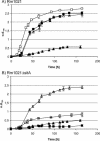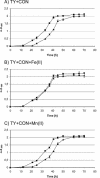The Sinorhizobium meliloti fur gene regulates, with dependence on Mn(II), transcription of the sitABCD operon, encoding a metal-type transporter
- PMID: 15150249
- PMCID: PMC415740
- DOI: 10.1128/JB.186.11.3609-3620.2004
The Sinorhizobium meliloti fur gene regulates, with dependence on Mn(II), transcription of the sitABCD operon, encoding a metal-type transporter
Abstract
Sinorhizobium meliloti is an alpha-proteobacterium able to induce nitrogen-fixing nodules on roots of specific legumes. In order to propagate in the soil and for successful symbiotic interaction the bacterium needs to sequester metals like iron and manganese from its environment. The metal uptake has to be in turn tightly regulated to avoid toxic effects. In this report we describe the characterization of a chromosomal region of S. meliloti encoding the sitABCD operon and the putative regulatory fur gene. It is generally assumed that the sitABCD operon encodes a metal-type transporter and that the fur gene is involved in iron ion uptake regulation. A constructed S. meliloti sitA deletion mutant was found to be growth dependent on Mn(II) and to a lesser degree on Fe(II). The sitA promoter was strongly repressed by Mn(II), with dependence on Fur, and moderately by Fe(II). Applying a genome-wide S. meliloti microarray it was shown that in the fur deletion mutant 23 genes were up-regulated and 10 genes were down-regulated when compared to the wild-type strain. Among the up-regulated genes only the sitABCD operon could be associated with metal uptake. On the other hand, the complete rhbABCDEF operon, which is involved in siderophore synthesis, was identified among the down-regulated genes. Thus, in S. meliloti Fur is not a global repressor of iron uptake. Under symbiotic conditions the sitA promoter was strongly expressed and the S. meliloti sitA mutant exhibited an attenuated nitrogen fixation activity resulting in a decreased fresh weight of the host plant Medicago sativa.
Figures







Similar articles
-
Mutation in the ntrR gene, a member of the vap gene family, increases the symbiotic efficiency of Sinorhizobium meliloti.Mol Plant Microbe Interact. 2001 Jul;14(7):887-94. doi: 10.1094/MPMI.2001.14.7.887. Mol Plant Microbe Interact. 2001. PMID: 11437262
-
RirA is the iron response regulator of the rhizobactin 1021 biosynthesis and transport genes in Sinorhizobium meliloti 2011.FEMS Microbiol Lett. 2005 May 15;246(2):235-42. doi: 10.1016/j.femsle.2005.04.012. FEMS Microbiol Lett. 2005. PMID: 15899411
-
Identification of a TRAP transporter for malonate transport and its expression regulated by GtrA from Sinorhizobium meliloti.Res Microbiol. 2010 Sep;161(7):556-64. doi: 10.1016/j.resmic.2010.05.004. Epub 2010 May 31. Res Microbiol. 2010. PMID: 20594941
-
Insights into the noncoding RNome of nitrogen-fixing endosymbiotic α-proteobacteria.Mol Plant Microbe Interact. 2013 Feb;26(2):160-7. doi: 10.1094/MPMI-07-12-0186-CR. Mol Plant Microbe Interact. 2013. PMID: 22991999 Review.
-
Denitrification in Sinorhizobium meliloti.Biochem Soc Trans. 2011 Dec;39(6):1886-9. doi: 10.1042/BST20110733. Biochem Soc Trans. 2011. PMID: 22103545 Review.
Cited by
-
Bacterial outer membrane channel for divalent metal ion acquisition.Proc Natl Acad Sci U S A. 2011 Sep 13;108(37):15390-5. doi: 10.1073/pnas.1110137108. Epub 2011 Aug 31. Proc Natl Acad Sci U S A. 2011. PMID: 21880957 Free PMC article.
-
Manganese transport is essential for N2 -fixation by Rhizobium leguminosarum in bacteroids from galegoid but not phaseoloid nodules.Environ Microbiol. 2017 Jul;19(7):2715-2726. doi: 10.1111/1462-2920.13773. Epub 2017 May 30. Environ Microbiol. 2017. PMID: 28447383 Free PMC article.
-
Fur controls iron homeostasis and oxidative stress defense in the oligotrophic alpha-proteobacterium Caulobacter crescentus.Nucleic Acids Res. 2009 Aug;37(14):4812-25. doi: 10.1093/nar/gkp509. Epub 2009 Jun 11. Nucleic Acids Res. 2009. PMID: 19520766 Free PMC article.
-
Iron homeostasis in the Rhodobacter genus.Adv Bot Res. 2013;66:10.1016/B978-0-12-397923-0.00010-2. doi: 10.1016/B978-0-12-397923-0.00010-2. Adv Bot Res. 2013. PMID: 24382933 Free PMC article.
-
Mur regulates the gene encoding the manganese transporter MntH in Brucella abortus 2308.J Bacteriol. 2012 Feb;194(3):561-6. doi: 10.1128/JB.05296-11. Epub 2011 Nov 18. J Bacteriol. 2012. PMID: 22101848 Free PMC article.
References
-
- Bagg, A., and J. B. Neilands. 1987. Ferric uptake regulation protein acts as a repressor, employing iron (II) as a cofactor to bind the operator of an iron transport operon in Escherichia coli. Biochemistry 26:5471-5477. - PubMed
-
- Bearden, S. W., and R. D. Perry. 1999. The Yfe system of Yersinia pestis transports iron and manganese and is required for full virulence of plague. Mol. Microbiol. 32:403-414. - PubMed
Publication types
MeSH terms
Substances
LinkOut - more resources
Full Text Sources

